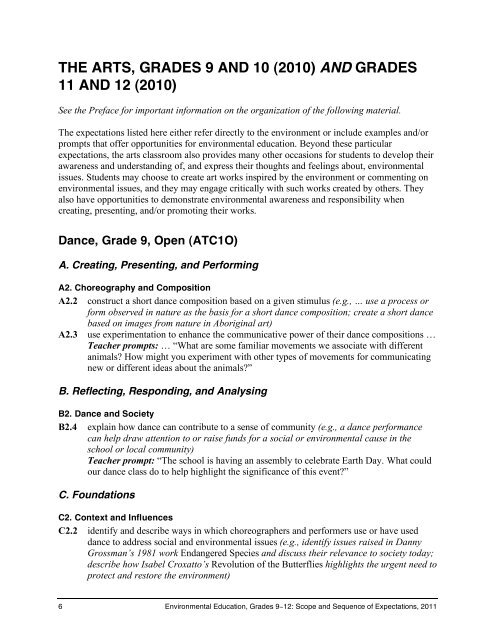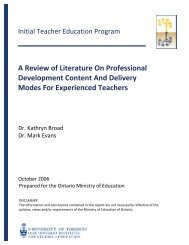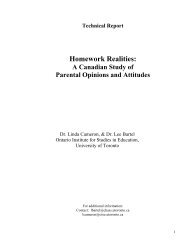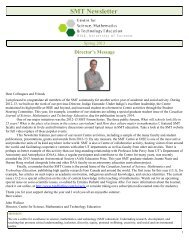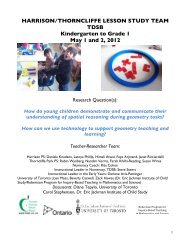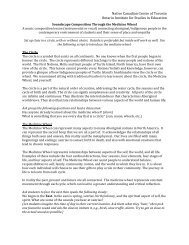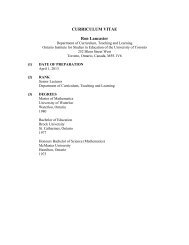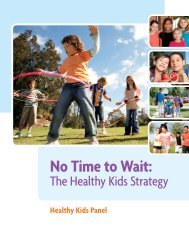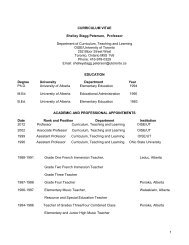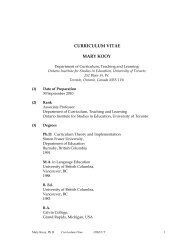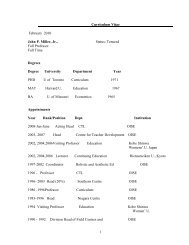The Ontario Curriculum, Grades 9-12 - Ministère de l'éducation ...
The Ontario Curriculum, Grades 9-12 - Ministère de l'éducation ...
The Ontario Curriculum, Grades 9-12 - Ministère de l'éducation ...
You also want an ePaper? Increase the reach of your titles
YUMPU automatically turns print PDFs into web optimized ePapers that Google loves.
THE ARTS, GRADES 9 AND 10 (2010) AND GRADES<br />
11 AND <strong>12</strong> (2010)<br />
See the Preface for important information on the organization of the following material.<br />
<strong>The</strong> expectations listed here either refer directly to the environment or inclu<strong>de</strong> examples and/or<br />
prompts that offer opportunities for environmental education. Beyond these particular<br />
expectations, the arts classroom also provi<strong>de</strong>s many other occasions for stu<strong>de</strong>nts to <strong>de</strong>velop their<br />
awareness and un<strong>de</strong>rstanding of, and express their thoughts and feelings about, environmental<br />
issues. Stu<strong>de</strong>nts may choose to create art works inspired by the environment or commenting on<br />
environmental issues, and they may engage critically with such works created by others. <strong>The</strong>y<br />
also have opportunities to <strong>de</strong>monstrate environmental awareness and responsibility when<br />
creating, presenting, and/or promoting their works.<br />
Dance, Gra<strong>de</strong> 9, Open (ATC1O)<br />
A. Creating, Presenting, and Performing<br />
A2. Choreography and Composition<br />
A2.2 construct a short dance composition based on a given stimulus (e.g., … use a process or<br />
form observed in nature as the basis for a short dance composition; create a short dance<br />
based on images from nature in Aboriginal art)<br />
A2.3 use experimentation to enhance the communicative power of their dance compositions …<br />
Teacher prompts: … “What are some familiar movements we associate with different<br />
animals? How might you experiment with other types of movements for communicating<br />
new or different i<strong>de</strong>as about the animals?”<br />
B. Reflecting, Responding, and Analysing<br />
B2. Dance and Society<br />
B2.4 explain how dance can contribute to a sense of community (e.g., a dance performance<br />
can help draw attention to or raise funds for a social or environmental cause in the<br />
school or local community)<br />
Teacher prompt: “<strong>The</strong> school is having an assembly to celebrate Earth Day. What could<br />
our dance class do to help highlight the significance of this event?”<br />
C. Foundations<br />
C2. Context and Influences<br />
C2.2 i<strong>de</strong>ntify and <strong>de</strong>scribe ways in which choreographers and performers use or have used<br />
dance to address social and environmental issues (e.g., i<strong>de</strong>ntify issues raised in Danny<br />
Grossman’s 1981 work Endangered Species and discuss their relevance to society today;<br />
<strong>de</strong>scribe how Isabel Croxatto’s Revolution of the Butterflies highlights the urgent need to<br />
protect and restore the environment)<br />
6 Environmental Education, <strong>Gra<strong>de</strong>s</strong> 9−<strong>12</strong>: Scope and Sequence of Expectations, 2011


